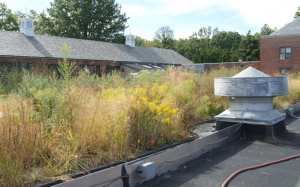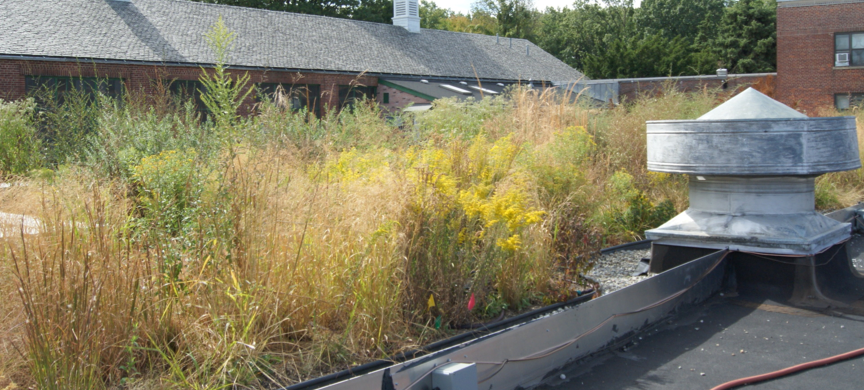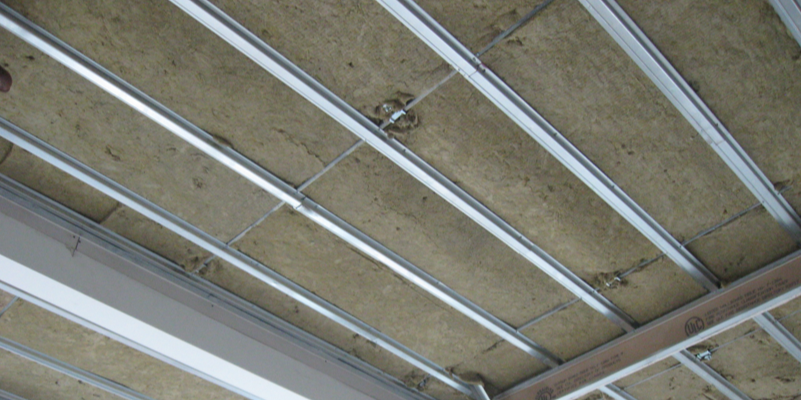Can stormwater management using rooftops in urban areas be the financial solution to our growing urban stormwater problem? Will public-private partnerships with building owners help to provide a government service—stormwater drainage—in a more cost-effective manner? As cities struggle with the high administrative and procurement costs and time delays to manage stormwater, should we be looking up to roofs as part of the solution? Can we avoid more regulations and instead look to market-based solutions? These questions are beginning to be discussed and tested as new, innovative approaches to solving difficult and expensive urban stormwater-management issues.

Consulting and engineering firm Geosyntec
Consultants is monitoring and controlling runoff from an existing New York City Parks and Recreation facility green roof.
STORMWATER MANDATES
Many cities and counties are dealing with more stringent stormwater permits issued from the Washington, D.C.-based U.S. Environmental Protection Agency (EPA) and state environmental agencies that implement the federal Clean Water Act. Many communities are operating under federal court orders and administrative consent orders from EPA to reduce stormwater runoff into rivers, lakes and streams. In addition, there are 177 communities in the U.S. where stormwater and wastewater-collection systems are combined, known as combined sewer overflows (CSOs). These CSOs result in billions of gallons per year of combined untreated stormwater and wastewater discharged into waterways during large rainfall events. Funding crises have developed in many municipalities as they create programs, hire new staff, and design and construct new infrastructure to meet these regulatory requirements.
Many cities have spent billions of dollars separating stormwater drainage from wastewater-collection systems by installing new, costly drainage systems. In addition, large underground storage tunnels and vaults have been installed by many cities at the costs of billions of dollars per installation. These tunnels and vaults are designed to collect, hold and slowly release the stormwater into the treatment network. Increasing stormwater pipe sizes and creating tunnels and vaults is extremely costly. For example, Washington, D.C., just broke ground on the construction of two stormwater tunnels that are currently projected to cost $2.6 billion dollars to construct. Just one of the tunnels will be 13-miles long and hold 157 million gallons of combined stormwater and wastewater in 23-foot-diameter tunnels, 100-feet below the surface.
Green-infrastructure approaches to stormwater issues are included in most municipal stormwater permits and orders. For example, New York City is spending $187 million on green infrastructure for stormwater control in CSO areas to control the equivalent of 1 1/2 inches of runoff from impervious surfaces by December 2015. Public and private areas are under consideration for green-infrastructure solutions, and the city expects to spend $2.4 billion in green infrastructure during the next 20 years.
As cities address urban stormwater management, stormwater fees are being assessed on private-property owners to help fund the programs to solve urban stormwater issues. Close to 1,500 stormwater utilities are now in operation in the U.S., and the number is rapidly growing. These stormwater utilities typically are assessing stormwater fees based on the amount of impervious surfaces by property owner. The fees can range from a few hundred dollars per year to tens of thousands.
Roofs are considered an impervious surface because they are designed to shed stormwater through drainage networks into the collection system beneath city streets. For example, in New York City alone roofs make up 11.5 percent of the total area, or roughly 944.3 billion square feet, according to the city’s Department of Design and Construction’s Cool & Green Roofing Manual. Rather than looking at roofs as part of the stormwater problem in cities, they should be viewed as a possible solution.
DID YOU KNOW?
Baltimore enacted a stormwater fee
in 2013. Currently a building with a
200,000-square-foot roof would be
assessed $11,400 per year.





Be the first to comment on "Roofs Are a Potential Solution for Urban Stormwater-management Issues"